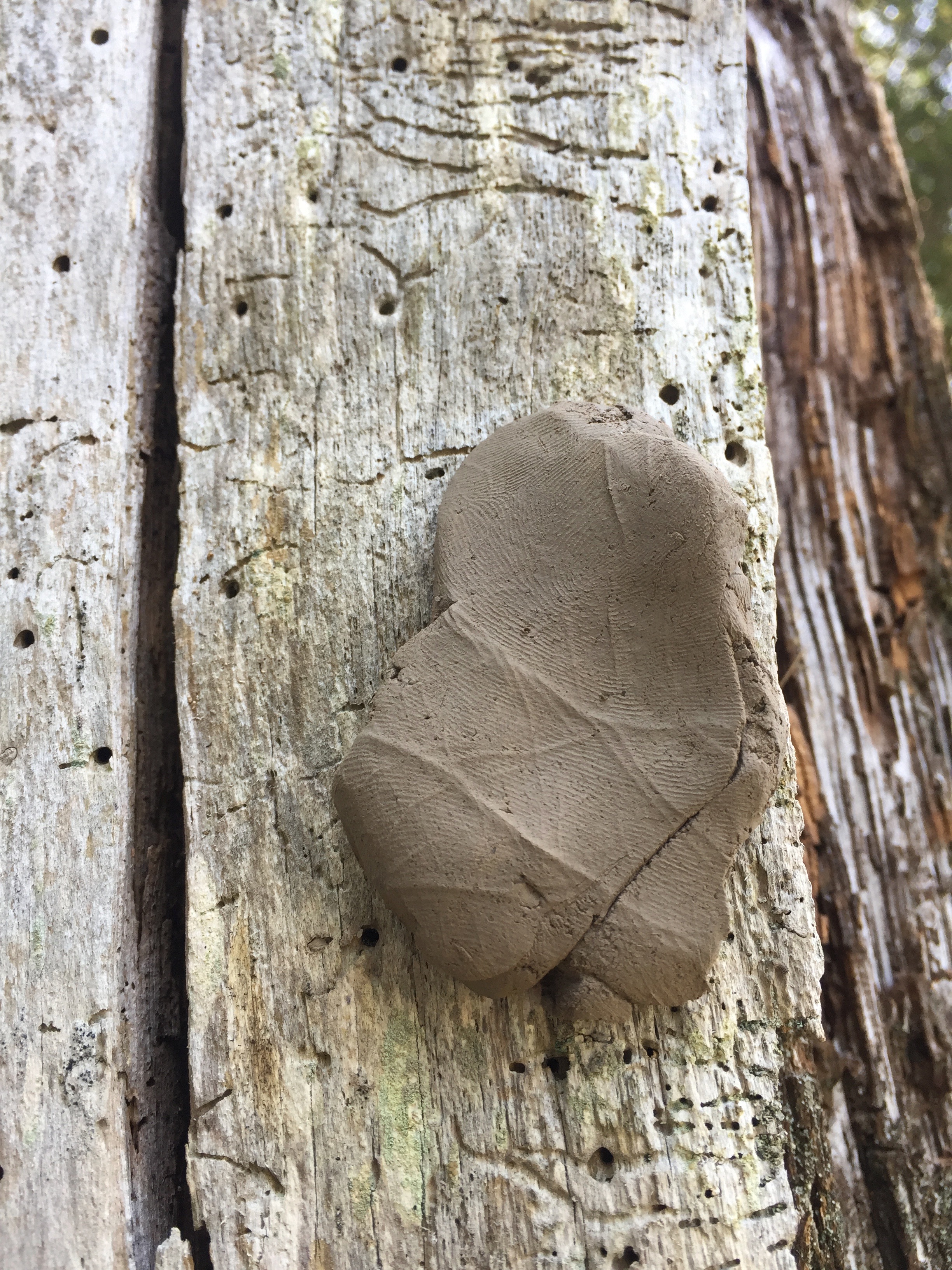Tracing Ways
2024 clay, earthenware, player piano, porcelain, risograph print, stoneware, textile
Collaborative Exhibition
with E. Saffronia Downing
Player piano collaboration with Bret Schneider
Comfort Station
Chicago, IL
image credit: Mikey Mosher

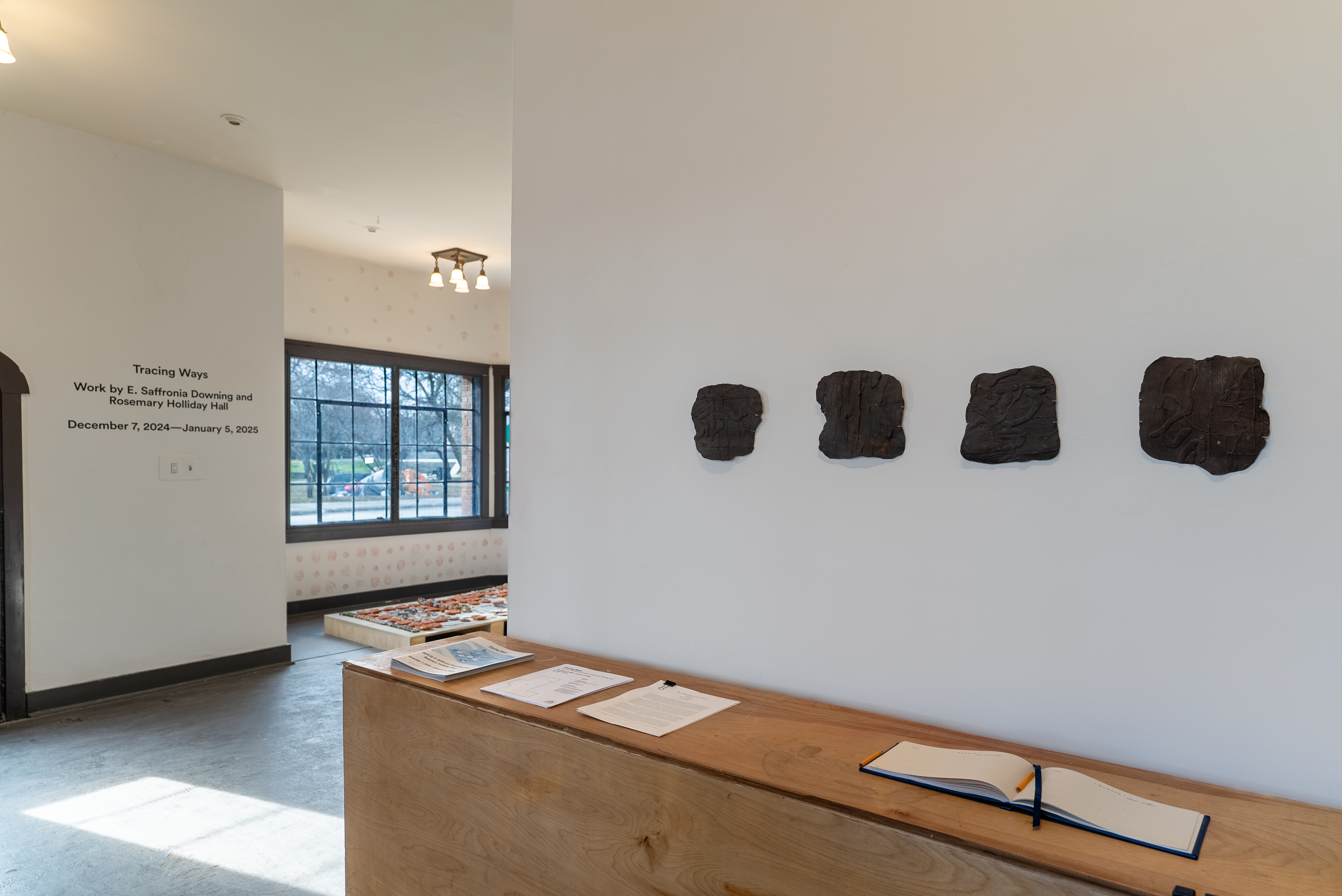




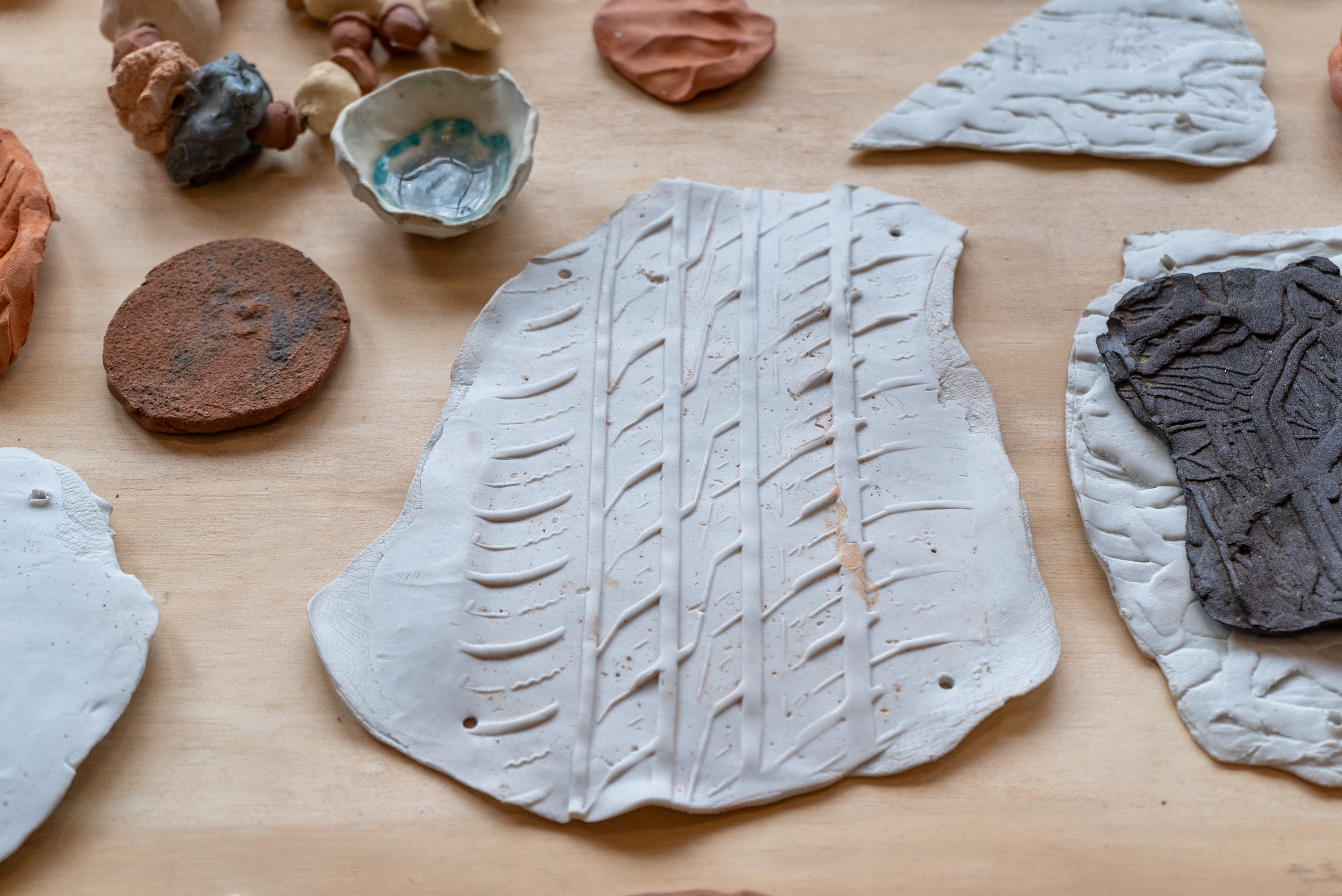

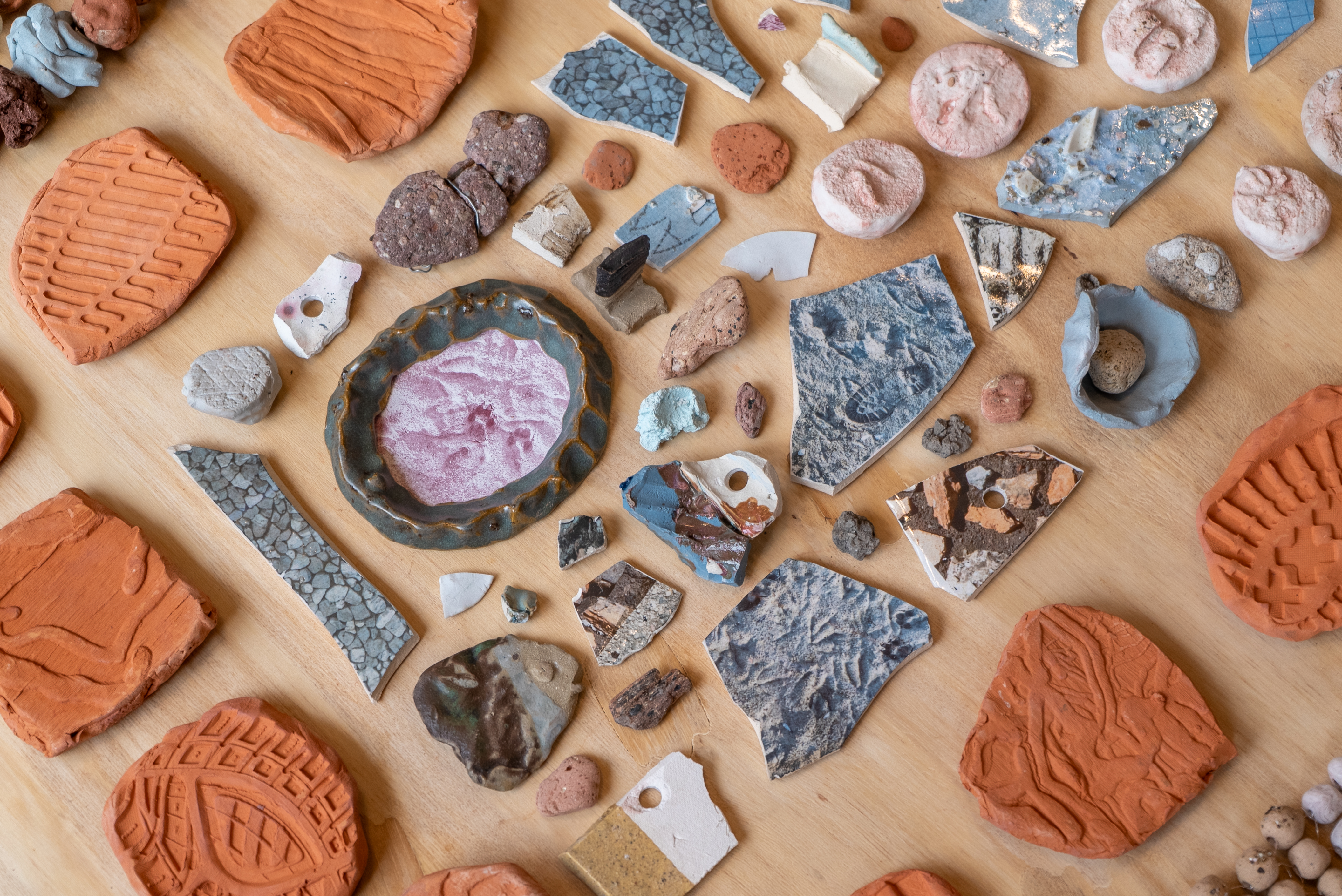




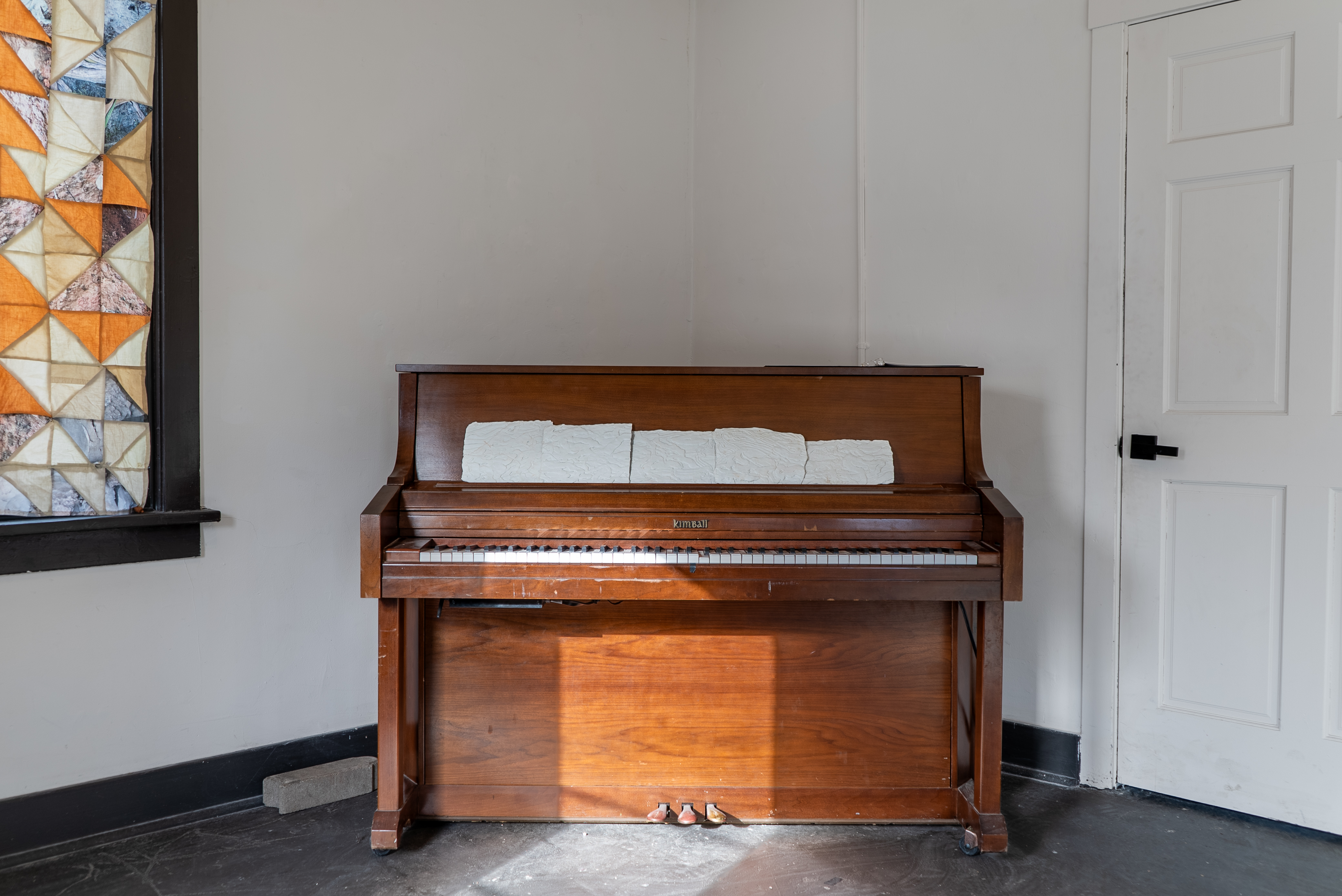



“Walking is how the body measures itself against the earth.”
– Rebecca Solnit, Wanderlust: A Brief History of Walking
– Rebecca Solnit, Wanderlust: A Brief History of Walking
Traces of movement, join and disperse– sneakers sink in soft soil, paw prints scamper across the sidewalk, paths of wood-boring beetles embroider a fallen tree. We mark our cohabitation as we criss-cross the continent.
Tracing Ways, is a site-specific installation that draws attention to the tracks and traces of human and more-than-human cohabitants. Living on parallel coasts, collaborators Rosemary Holliday Hall and E. Saffronia Downing, convene at Comfort Station to weave together a collection of tracks gathered from their disparate environments.
For these transient artists, Tracing Ways becomes a stopover, referencing Comfort Station’s history as a space for travelers to pause as they moved through the city. Using clay as a recording device, Downing and Hall capture and suspend the ever-flowing motion of beings against the earth.
In the Realm of Spiders
2024
car windows, greenhouse structure, black widow spider silk, brick, oak leaves, metal, porcelain, iron oxide
Group Exhibition
curated by Cassandra C. Jones
Ojai Valley Museum
Ojai, CA
2024
car windows, greenhouse structure, black widow spider silk, brick, oak leaves, metal, porcelain, iron oxide
Group Exhibition
curated by Cassandra C. Jones
Ojai Valley Museum
Ojai, CA
image credit: Mikael Jorgensen






















Curiosity, over fear, compelled six local artists to create work about spiders. Some explored the geometry of their webs and pondered their unique personalities. Others thought about their powerful contributions to humans as pest control and pollinators. All looked for the good in them as a species. Each acknowledged, in their own way, something special about who spiders are and what they accomplish. By doing so, they urge us to reexamine our view of them, and acknowledge their importance to all life on earth. - Cassandra C. Jones
Artists include:
Joel Fox
Rosemary Holliday Hall
Cassandra C. Jones
Jeff Mann
Steve Sprinkle
Jamie Stratford
Joel Fox
Rosemary Holliday Hall
Cassandra C. Jones
Jeff Mann
Steve Sprinkle
Jamie Stratford
Swarm
2024
car windows, porcelain, metal
Site-specific Installation Taft Gardens Art in Nature Residency Exhibition
Taft Gardens
Ojai, CA
image credit: Jules Branaman
2024
car windows, porcelain, metal
Site-specific Installation Taft Gardens Art in Nature Residency Exhibition
Taft Gardens
Ojai, CA
image credit: Jules Branaman
Umwelt, coined by biologist Jakob von Uexküll illustrates how every organism perceives the world uniquely, shaped by their distinct sensory faculties.
”… We must first blow a soap bubble around each creature to represent its own world, filled with the perceptions which it alone knows. When we ourselves then step into one of these bubbles, the familiar meadow is transformed. Many of its colorful features disappear, others no longer belong together but appear in new relationships. A new world comes into being.”
The automobile industry has created its own pervasive bubble, reshaping our environment in significant ways. It has contributed to habitat fragmentation, clouded the atmosphere with emissions, and altered our experience of landscapes through speed. The car window acts as a filter, turning the world into a blur of fleeting impressions.
Swarm is an installation that examines this transformed landscape. Suspended hand-drawn pollinator insects on porcelain clay-coated car windows, serve as both screens and reflections. This work explores how human and industrial impacts alter our perception of nature and its vitality. The decline of insects reveals our deep connection to a balanced ecosystem.
Encyclia imagosis, Taphonomy
2024
metal & oxidized textile
Site-specific Installation Taft Gardens Art in Nature Residency Exhibition
Taft Gardens
Ojai, CA
image credit: Jules Branaman
2024
metal & oxidized textile
Site-specific Installation Taft Gardens Art in Nature Residency Exhibition
Taft Gardens
Ojai, CA
image credit: Jules Branaman







Encyclia imagosis, Taphonomy; a series of oxidizing chrysalis sculptures buried in leaf litter, like a moth pupa, emerge in spring marked by the passage of time, soils, and decomposers.
See Dew
2023 metal & oxidized textile
Nicrocosm
s: Studies on Scavenging and Renewal
exhibition curated by Tracie Hayes
Bodega Bay Marine Lab Bodega Bay, CA
image credit: Elizabeth Herring
2023 metal & oxidized textile
Nicrocosm
s: Studies on Scavenging and Renewal
exhibition curated by Tracie Hayes
Bodega Bay Marine Lab Bodega Bay, CA
image credit: Elizabeth Herring










See Dew is a human-scale fog collector that takes the form of a Nicrophanous beetle pupa to explore how plants, animals, and humans adapt, collect, and navigate through mystic landscapes of fog. See Dew focuses on seeing what the place does and how the body is embedded in that being.
>>>
Nicrocosms: Studies on scavenging and renewal is an outdoor group exhibition showcasing the work of 9 artists engaging with themes related to the life history and ecological research on a scavenging beetle present at the site
Beetles in the genus Nicrophorus, or burying beetles, search for a small carcass that they then bury in the soil in order to reproduce. A pair of burying beetles will work together to defend the rare, ephemeral, and high-nutrient carcass from microbial competitors and other interested organisms. They bury the carcass together and the female will lay eggs nearby. Once the carcass has been protected, buried, and preserved, both parents use the carrion to feed their larvae when they hatch.
In my research at the Bodega Marine Reserve, I use experimental chambers in the field to investigate the effects of temperature, competition, resource quality, microhabitat, and fog regime on burying beetle reproductive success. I have been calling these chambers nicrocosms, after Paul E. Hopwood et al.’s 2016 paper in Ecological Entomology. In this paper, nicrocosm is a play off of microcosm or mesocosm, an experimental set-up used in ecology to run controlled manipulations in small spaces that are still relevant to and part of the natural world. The root cosm, though, holds an even greater weight, meaning “world,” “order,” and “universe.” In this way, each nicrocosm in the field encapsulates an entire universe: an answer to an ecological question, the life’s work of an unseen beetle, birth and death, and the passing of time.
This exhibition will consist of works that serve as nicrocosms themselves, portals into the often overlooked and misunderstood world of scavengers. Burying beetles, in many ways, are the ultimate scavengers: they rely on and are adapted to a fleeting resource, and they play a crucial role in processing the dead so that those nutrients can be used again by the greater ecosystem. Whether using local and found materials, circular and sustainable processes, visual storytelling, or some combination, each artist provides a novel way to see and experience the living world we are within. - -Tracie Hayes
Nicrocosms: Studies on scavenging and renewal is an outdoor group exhibition showcasing the work of 9 artists engaging with themes related to the life history and ecological research on a scavenging beetle present at the site
Beetles in the genus Nicrophorus, or burying beetles, search for a small carcass that they then bury in the soil in order to reproduce. A pair of burying beetles will work together to defend the rare, ephemeral, and high-nutrient carcass from microbial competitors and other interested organisms. They bury the carcass together and the female will lay eggs nearby. Once the carcass has been protected, buried, and preserved, both parents use the carrion to feed their larvae when they hatch.
In my research at the Bodega Marine Reserve, I use experimental chambers in the field to investigate the effects of temperature, competition, resource quality, microhabitat, and fog regime on burying beetle reproductive success. I have been calling these chambers nicrocosms, after Paul E. Hopwood et al.’s 2016 paper in Ecological Entomology. In this paper, nicrocosm is a play off of microcosm or mesocosm, an experimental set-up used in ecology to run controlled manipulations in small spaces that are still relevant to and part of the natural world. The root cosm, though, holds an even greater weight, meaning “world,” “order,” and “universe.” In this way, each nicrocosm in the field encapsulates an entire universe: an answer to an ecological question, the life’s work of an unseen beetle, birth and death, and the passing of time.
This exhibition will consist of works that serve as nicrocosms themselves, portals into the often overlooked and misunderstood world of scavengers. Burying beetles, in many ways, are the ultimate scavengers: they rely on and are adapted to a fleeting resource, and they play a crucial role in processing the dead so that those nutrients can be used again by the greater ecosystem. Whether using local and found materials, circular and sustainable processes, visual storytelling, or some combination, each artist provides a novel way to see and experience the living world we are within. - -Tracie Hayes
Carbon Copy
2023
asphalt, basalt, brick, cement, clay, fossilized whale vertebrate, limestone, sandstone, soil, shells, stoneware, shovels, steel, tar, tile
Collaborative Exhibition with Joshua G. Stein curated by Kitty Ross
AB Projects Los Angeles, CA
2023
asphalt, basalt, brick, cement, clay, fossilized whale vertebrate, limestone, sandstone, soil, shells, stoneware, shovels, steel, tar, tile
Collaborative Exhibition with Joshua G. Stein curated by Kitty Ross
AB Projects Los Angeles, CA






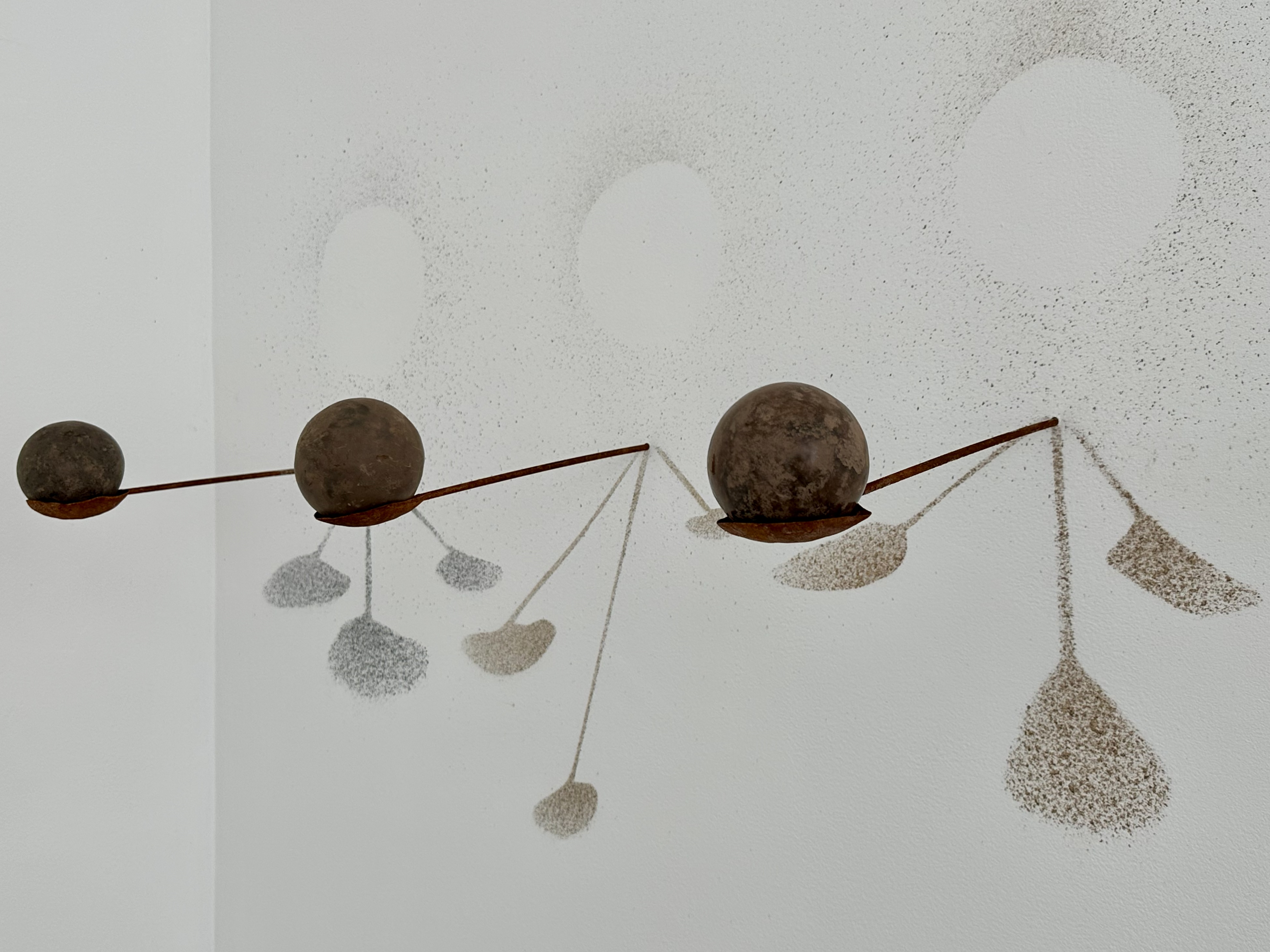




Months of conversations between artists Rosemary Holliday Hall, Joshua G. Stein (Radical Craft), and guest curator Kitty Ross revolved around notions of material in geologic, biologic, architectural, atmospheric, and ceramic iterations.
If the landscape consists of the earth and the atmosphere, architecture exists between the two. Material particles—animal, vegetable, and mineral—move between these realms, blurring the boundaries of each. Hardened compounds like limestone were once living creatures. Hermit crabs collect minerals and objects from their surroundings to shield their bodies in a protective enclosure. Humans dig vast pits to harvest materials to erect buildings of the very materials upon which their architecture stands. The cavities are then filled with debris, either deliberately or via the ongoing movement of particles, and the pit becomes a mound. Birds swallow gastroliths as a mechanism for grinding food in their gizzards. Whales, seals and crocodiles are also known to swallow gastroliths, perhaps to serve as ballast. The soft body of an oyster transforms mineral irritants into pearls. Conversely, body ‘stones’ such as gallstones, bladder stones and kidney stones are painful formations of somatic minerals. The human body is geology and, accordingly, we humans are geologic agents.
This exhibition is a poetic examination of the transference, atomization and tracing of materials over time, and a means of questioning how we live, build, make, and evolve in the Anthropocentric landscape. - Kitty Ross
Chrysalis lepidoptera
2021
video
becoming Feral
Digital & Print publication published & designed by Objet-a Creative Studio
2021
video
becoming Feral
Digital & Print publication published & designed by Objet-a Creative Studio




Becoming connotes the recurrent act of deconstructing boundaries between bodies, constructing malleable new edges in which both identities exist simultaneously - a continual performance of immanence and difference...Becoming-feral constitutes a line of flight away from individuated and subjugated life forms, which are policed by the logistics of human exceptionalism, towards the messy mystical multiplicity of a world in common, a world of shared and multitudinal ecologies.
- Chessa Adsit-Morris, becoming Feral
now imagine
you’re a caterpillar
filmy eyes,
wet creased wings
slushy slop
you’re a caterpillar
filmy eyes,
wet creased wings
slushy slop

becoming—Feral is a creative research publication which aims to investigate the complex relationships between human/other-animals and the shifting categories of wild/feral/domestic, set within landscapes constantly being altered by global transformations of climate and capitalism. We are interested in exploring reciprocal and responsive multispecies reactions to the act of becoming-Feral.
The becoming—Feral Digital Collection acts as a companion collection to the print publication, presenting multimedia and extended entries of video art, audio/music, interviews, and photographic essays.
The becoming—Feral Digital Collection acts as a companion collection to the print publication, presenting multimedia and extended entries of video art, audio/music, interviews, and photographic essays.
de| composition
2021
performance & printmedia
Sound Scene Fest: Emerge
Group Performance Festival created by DC Listening Lounge
Washington, DC
2021
performance & printmedia
Sound Scene Fest: Emerge
Group Performance Festival created by DC Listening Lounge
Washington, DC




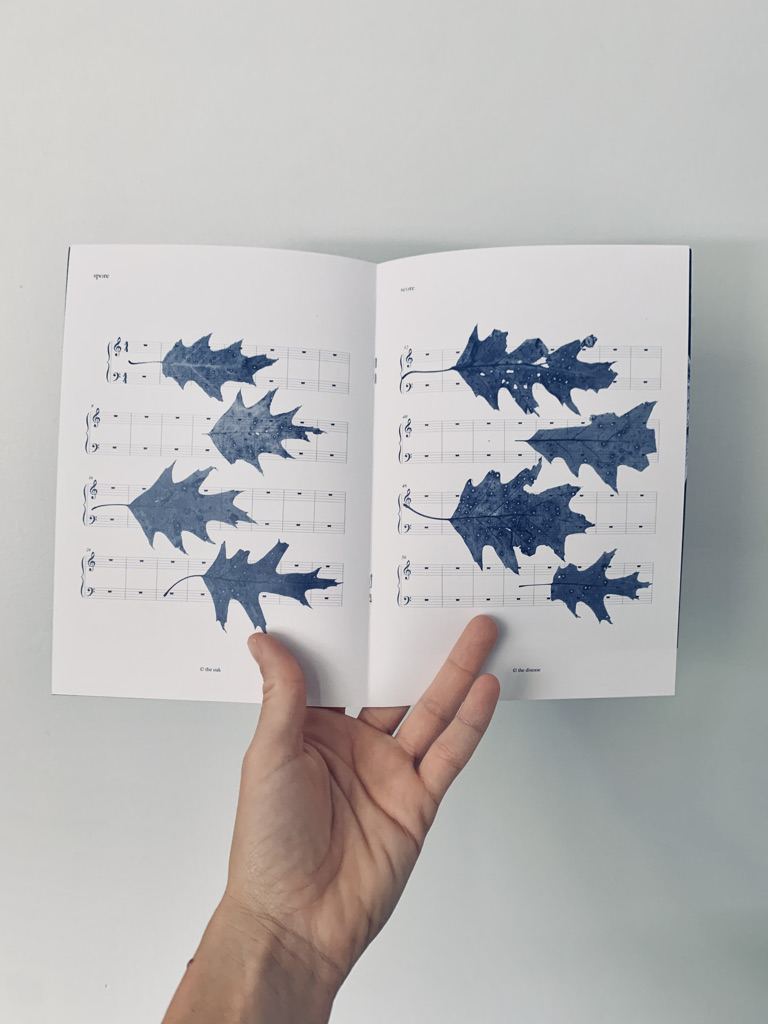
A decaying leaf offers the opportunity for continual iteration, composition, and interpretation. de | composition as an ongoing project that aims to tune a curious listener to the unfurling world of possibility in the earth’s multifaceted ability to communicate.

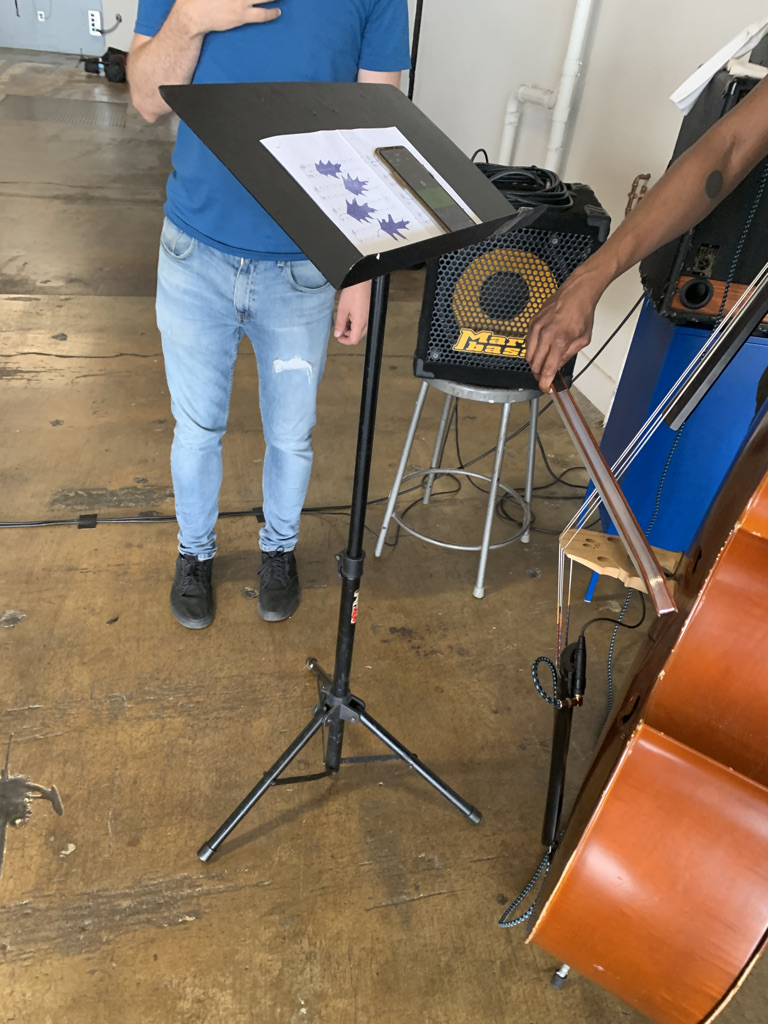

Interpretations:
Surface Tension
2021
video installation & printmedia
Group Exhibition Curated by Pia Singh
Heaven Gallery
Chicago, IL
Dec 11- Jan 24
2021
video installation & printmedia
Group Exhibition Curated by Pia Singh
Heaven Gallery
Chicago, IL
Dec 11- Jan 24
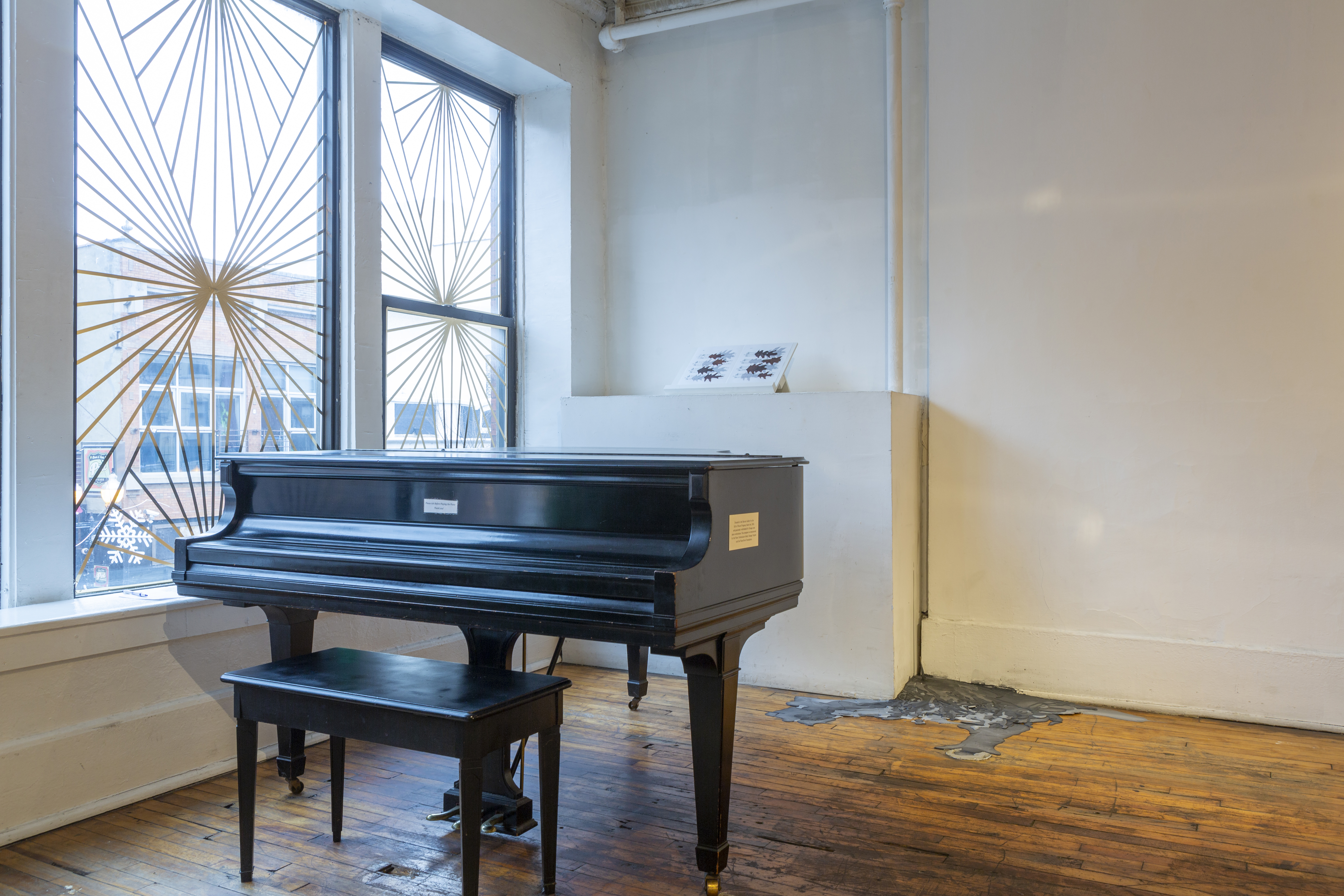
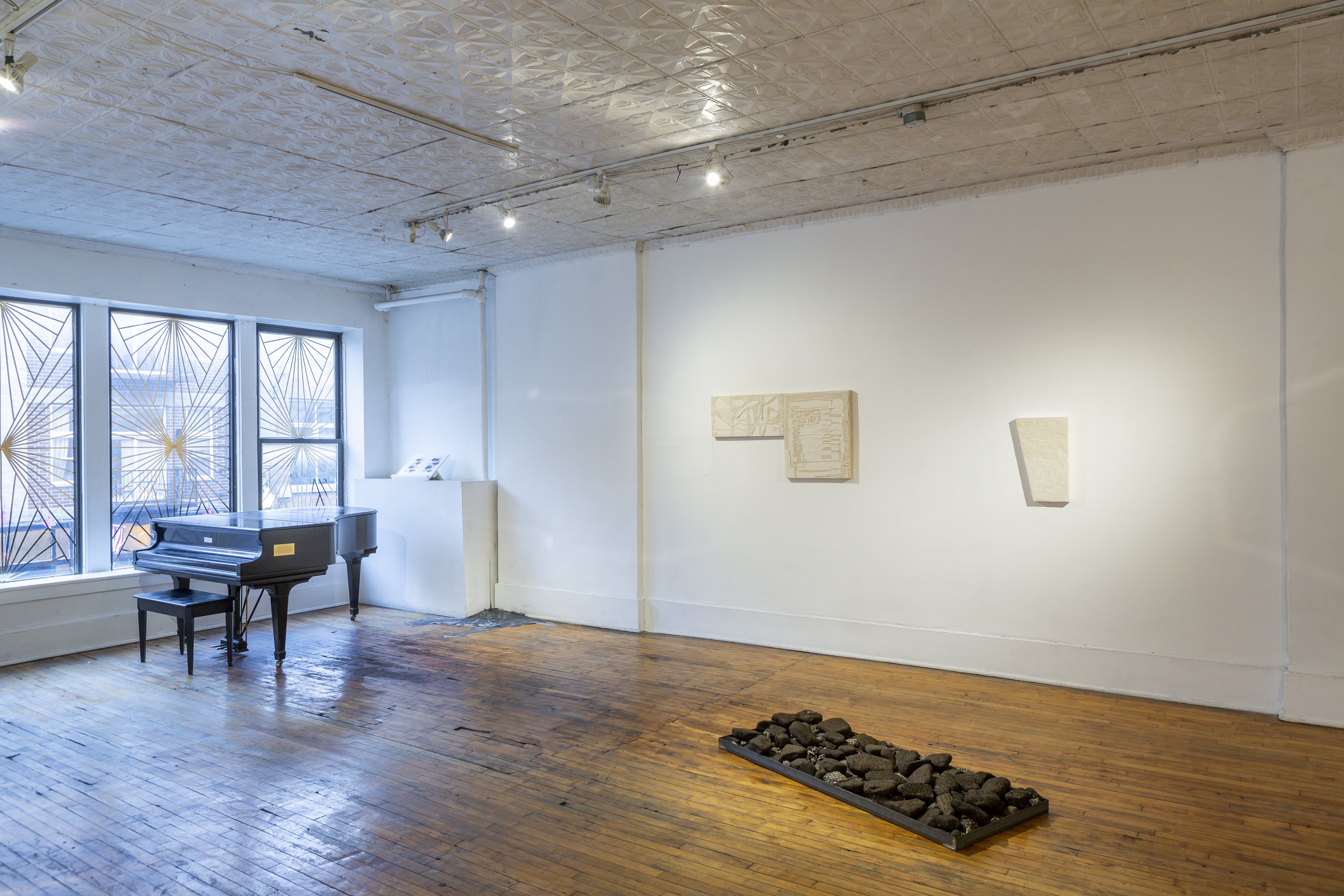





The evolution of natural forms and the evolution of human perception have coincided to produce the phenomenon of a potential recognition: what is and what we can see sometimes meet at a point of affirmation. This point, this affirmation, is two-faced: what has been seen is recognized and affirmed, and at the same time the seer is affirmed by what he sees.
-John Berger, 2016
Surface tension is a condition that is created by an entanglement of electrons. Electrons that are sensitive to the presence of magnetic fields. They entangle, enmesh, proliferate one another, combining and recombining to create different conditions to achieve different states. What state are you in while viewing this exhibit? What state are we in, collectively, in relation to history?
Rosemary Holliday Hall’s site specific installation ‘Adhesion’ is an assemblage of the artists interest in nature, forms, and patterns, and how humanity interacts with these elements (specifically in conditions of the crisis). Hailing from Los Angeles, Hall spent the initial months of 2020 relocating from Chicago to the West coast. Traversing the country at the beginning of summer, she spent weeks physically immersing herself, bodily processing ‘poesis’ with the earth. According to Heidegger, ‘poesis’ can be found in the blooming of a blossom, or the coming-out of a butterfly from its cocoon. This threshold, the moment ecstasis, is where Hall positions her inquiry. Reflecting on how experience and perception are conditioned by time and repetition, the artist melds the moment of the ‘event’ with a memory of it, while drawing up a conjuring or dream of the same. ‘Permeable Permutations’ captures autumn colored leaves with natural spore variations or bacterial discolorations, arranged as sheet music. What can be heard in a display of warning signs? Could this be read as a tune or is it nature's silent scream, a sort of self-cannibalism in protest of the climate crisis we’re currently experiencing? Hall arranges spotted yellowing leaves as sheet music for the viewer, who is also the player, inviting them to take part in the process of dying. Looking closely at nature during a global pandemic, a civil uprising and a US election year, Hall and her peers' works speak to a variety of concerns. To sit with the experience of non-locality (the basic connectivity of everything in nature), each of us become the determiner of what we choose to see (and be). The observer as the observed. The participant, as maker. The thinker, as doer. - Pia Singh
River of Shadows, Liquidation
2020
installation: video porcelain slip cast plants, spoons made from smashed pennies and steel, seed packets of native plants
Group Exhibition
Third Coast Disrupted: Artists + Scientists on Climate curated by Christine Esposito
Glass Curtain Gallery Chicago, IL
image credit: Columbia College
2020
installation: video porcelain slip cast plants, spoons made from smashed pennies and steel, seed packets of native plants
Group Exhibition
Third Coast Disrupted: Artists + Scientists on Climate curated by Christine Esposito
Glass Curtain Gallery Chicago, IL
image credit: Columbia College


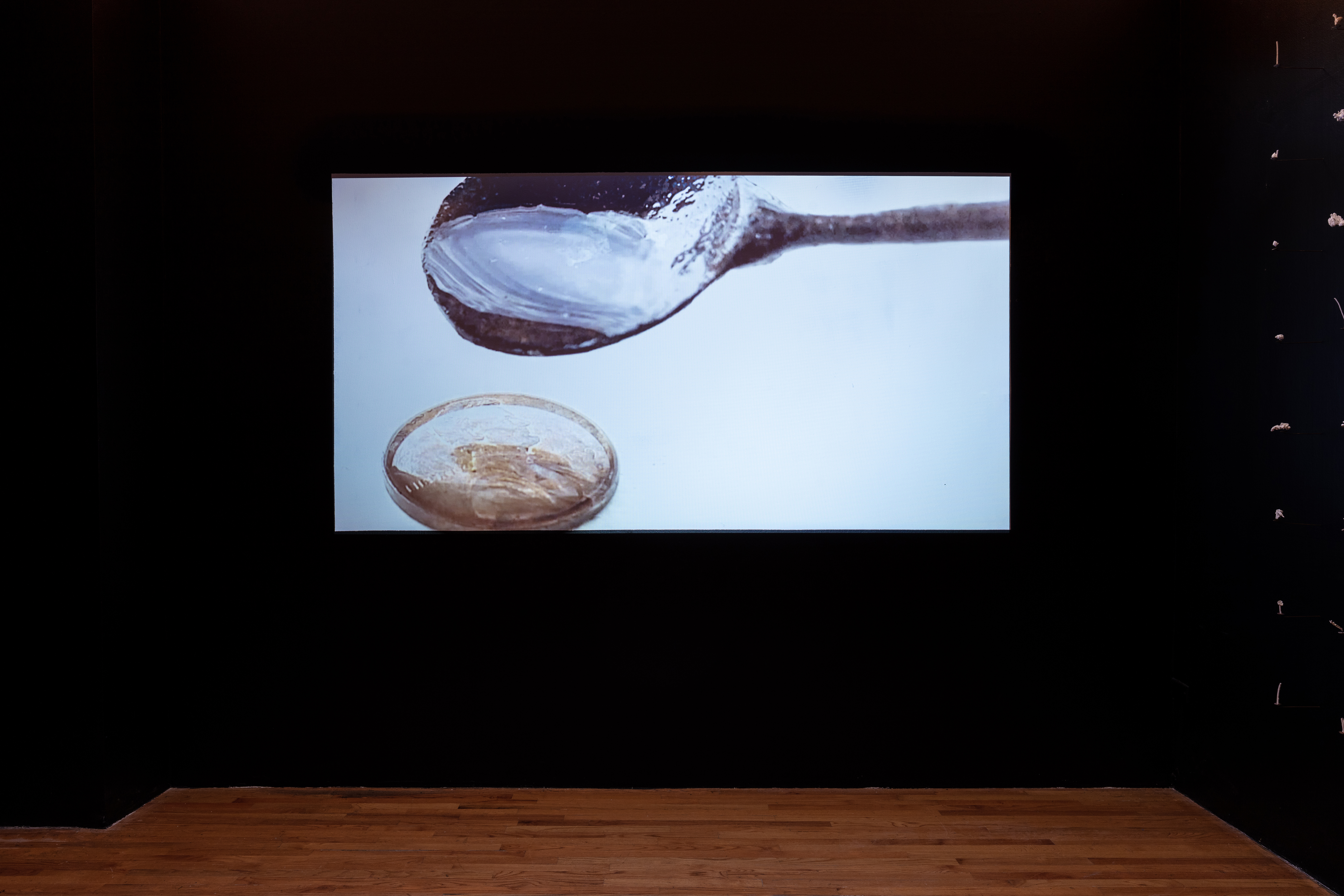





Third Coast Disrupted: Artists + Scientists on Climate is an exhibition of artworks culminating a yearlong conversation between artists and scientists centered on Climate Change impacts in the Chicago region and beyond.
Hall’s multimedia installation explores economies and ecologies of water as a subject of tension. As temperatures rise the atmosphere can physically hold more water, which is made visible through extreme weather events, flooding, and drought throughout the planet.
In a dark room the viewer is enveloped in the folk song “Goin’ Down the Road Feelin Bad” sung by Ward H Ford. Projected on one wall is a spoon pouring water onto a larger-than-life penny, reaching capacity. The video suggests value systems based in economies of extraction have driven the road we are on to a bad place, a catastrophic tipping point. Accompanying the video is an installation of 108 ceramic casts of water retaining plants and seeds, which ask- how might we plant seeds for a living and more resilient future? Like ghosts of the present, the plants suggest the future of our planet lies in systems of value beyond monetary systems and towards those that value care and an understanding of the inter-being of all organisms.
Participating Artists: Jeremy Bolen, Barbara Cooper, Hector Duarte, Rosemary Holliday Hall, N. Masani Landfair, Meredith Leich, Andrew Yang
Participating Scientists: Elena Grossman, MPH; Daniel Horton, Ph.D.; Abigail Derby Lewis, Ph.D.; Aaron Packman, Ph.D.; Katherine Moore Powell, Ph.D; Desi Robertson-Thompson, Ph.D., Phil Willink, Ph.D
Encylia imagosis
2020
metal & oxidized textile
Solo Exhibition curated by Aron Gent
Paris London Hong KongChicago, IL
image credit: PLHK
2020
metal & oxidized textile
Solo Exhibition curated by Aron Gent
Paris London Hong KongChicago, IL
image credit: PLHK


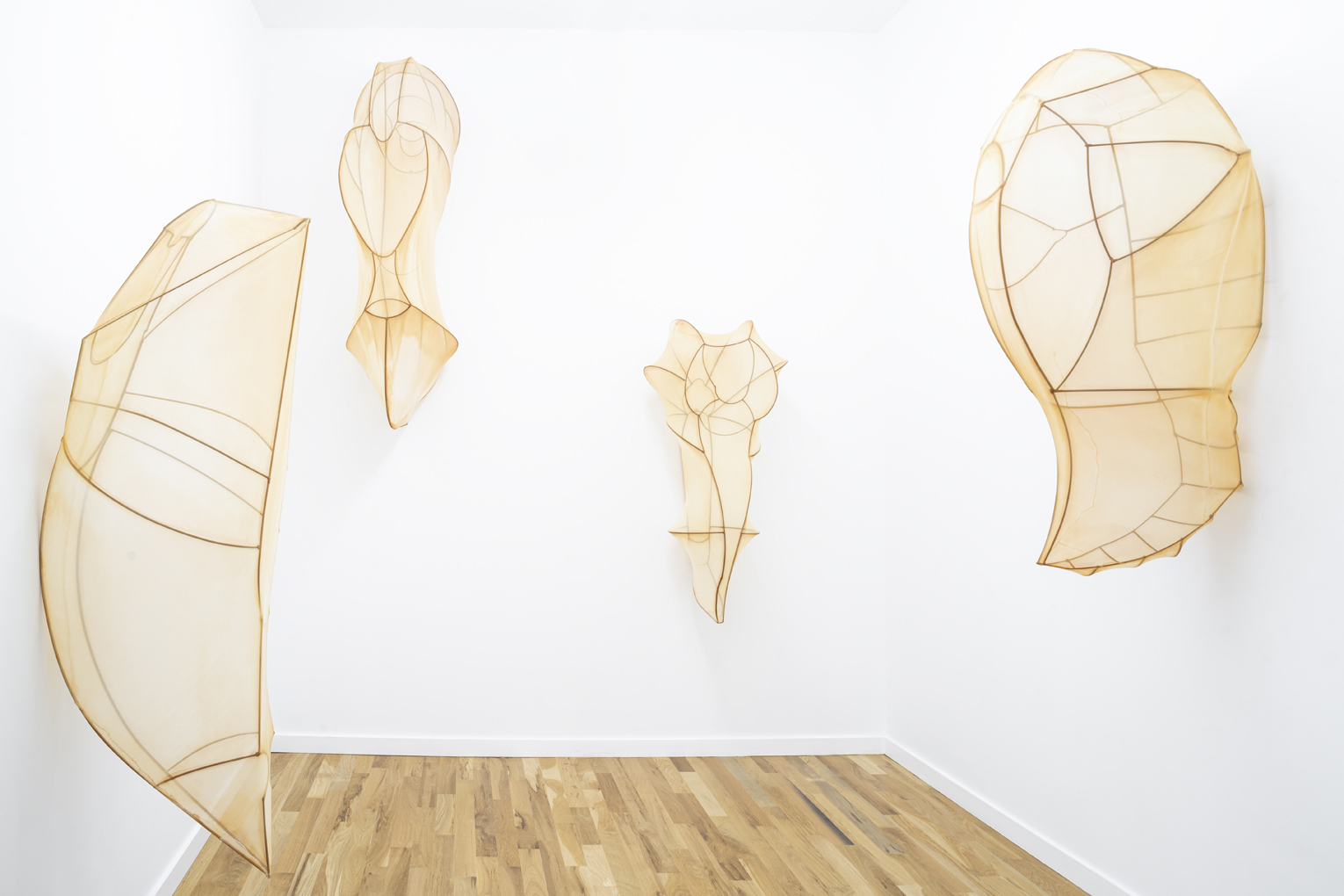










On the one hand, Encyclia Imagosis reads like a spell, and on the other the scientific discourse of taxonomy. Encyclia Imagosis stems from Greek, enkykleomai, “to encircle”, imago, imagination’s root, and osis, a suffix denoting a process or condition. Encyclia Imagosis casts a spell on categorical fixity. It proposes a cyclical destabilization and refashioning of imagination’s role in the processes of transformation, like a child’s incantation challenging the malaise of taxonomy.
The Codex Seraphinianus is an illustrated encyclopedia of an imaginary world, created by Luigi Serafini, written in a self-invented alphabet. It contains hundreds of hybrids, imaginary and strange beings: a horse transforms into a cocoon, a bird’s nest sprouts legs with yellow sneakers, lovers become a crocodile. Each undergoes metamorphosis, creatively overcoming bodily limits. Many real creatures are stranger than imagined. The caterpillar, for example, encases itself in a chrysalis into which it releases enzymes that digest its own form, liquidating its’ tissues. Only structures called imaginal discs survive, able to reorder the larval soup into a new being. Through this process of imagination, caterpillars push themselves into a different future, the confines of their chrysalis paradoxically enabling their flight forward into the unfamiliar, just as the imagination does for other species.
Encyclia Imagosis consists of four human-scale oxidizing chrysalis sculptures. They mark an evolutionary world, where objects are process and forms are dynamic patterns creating symmetries, hybrids, mutations. Through an embodied exploration of the possibilities of reorienting both personal perception and cultural convention, Encyclia Imagosis investigates various ways we make sense of the world and relate to ourselves and others through imagination, metaphor, and material.
Collabiosis
2020
site-specific installation: windshields, steel, garage
Solo Exhibition + Artist Residency at The Blue Parrot
The Blue Parrot
Chicago, IL
This project was made possible thanks to the support of Emilio Williams and Dr. Robert Murphy
image credit: Astro Escuadero
2020
site-specific installation: windshields, steel, garage
locally sourced clay, steel spoons, brick
Solo Exhibition + Artist Residency at The Blue Parrot
The Blue Parrot
Chicago, IL
This project was made possible thanks to the support of Emilio Williams and Dr. Robert Murphy
image credit: Astro Escuadero







The solo exhibition, Collabiosis, culminated a multi-month artist residency at the Blue Parrot in Chicago, IL.
Collabiosis
/kəˈlabi ōsis|
A process or condition of collapsing together.
/kəˈlabi ōsis|
A process or condition of collapsing together.
The name of the exhibition, Collabiosis, is an invented word that comes from combining - collabi ( the etymological root of collapse and collaboration) and osis (a suffix denoting a process or condition of change). Throughout the exhibition the installations respond to the site and different material histories of Chicago.
︎︎︎︎
“A single animal’s rebellion rendering mass destruction while also clearing the stage for a phatasmagoric theater of the future. Old Chicago burned to the ground and modern Chicago grew.”- Hannah B. Higgins
The famous cow mythology marks a genesis of Chicago’s grid, reflected in its’ brick buildings. After the devastating fire on October 8,1871 Joseph Mendill proclaimed in the Chicago Tribune, “Modern Chicago would be a grid.” This installation presents a spectral reordering of grids that lay beneath Chicago’s material and discursive history within The Blue Parrot, located on 1924 N Halsted St: 41°55’00.3”N+87°38’55.1”W:3.5 miles away from the Zero-Zero Point of the Chicago grid. It consists of unfired spheres made out of clay collected from various open construction sites surrounding The Blue Parrot. These locations representative of the continuous loop of (de)construction in everyday life. The sphere, like a seed acts as a symbol for new beginnings built from long embeded material histories.
Stigmergy || The Space Inside Repetition
2020
installation: termites, sound, cabinet, book, cds, acrylic
Public Presentation + Exhibition
Collaboration with Predrag Popovic
Phd in Geophysical Sciences
University of Chicago
ASCI University of Chicago
Chicago, IL
This project was made possible thanks to the support of The Art Science and Culture Initiative
Initiative at The University of Chicago and School of the Art Institute of Chicago
image credit: Brittany Laurent
installation: termites, sound, cabinet, book, cds, acrylic
Public Presentation + Exhibition
Collaboration with Predrag Popovic
Phd in Geophysical Sciences
University of Chicago
ASCI University of Chicago
Chicago, IL
This project was made possible thanks to the support of The Art Science and Culture Initiative
Initiative at The University of Chicago and School of the Art Institute of Chicago
image credit: Brittany Laurent




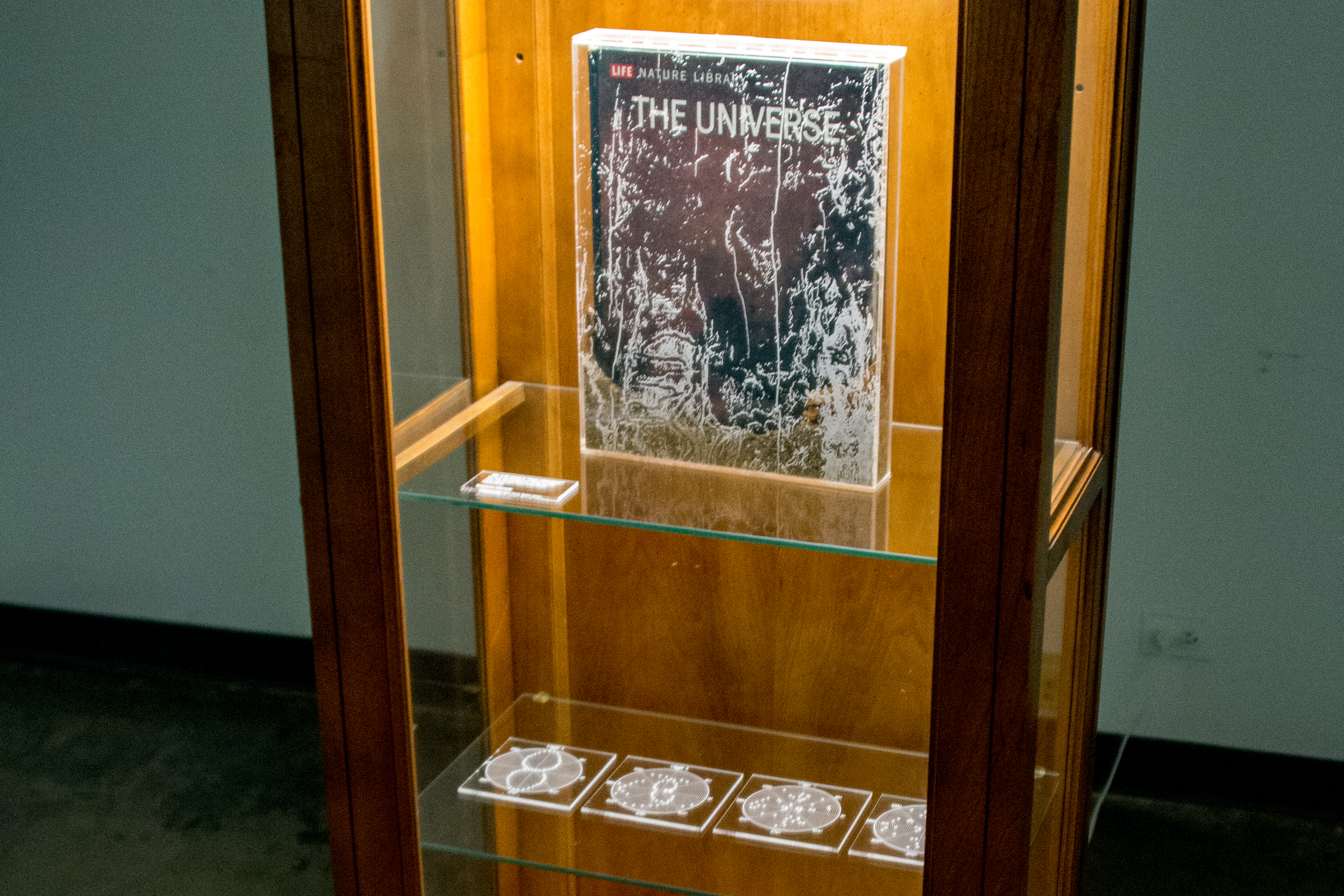

The patterns of bird flocking, microbial growth, and insect colonies have captured the human imagination for centuries. These patterns demonstrate swarm intelligence, a process where an emergent order arises from seemingly random biological activity, and where apparently dissimilar systems can show very similar behaviour. Predrag Popovic (PhD candidate, Geophysical Sciences, UChicago) and Rosemary Hall ’s (MFA ‘19, Printmedia, SAIC) research focused on the oldest eusocial insect, the termite, and stigmergy (a key concept in the field of swarm intelligence).
The collaboration resulted in a multimedia installation, which included a sound filtering algorithm modeled after stigmergy and a library of books eaten by live termites. The termites ate a book from Life Nature Series, titled, The Universe.Cellulose pages and maps of the cosmos were submitted to termite editing. In time, the termites consumed and created their own architecture out of The Universe.
Through wondering in a termite’s wandering this collaboration searched for hybrid, inbetween, and experimental, translations that invite a broader spectrum of interpretation. Our flesh, our limbs, our movements are inscribed with a multispecies history. The pattern which connects may be best articulated through the poetry of interspecies relations, movements and behaviour.
A Predicament of Pressure
2019
locally souced clay, steel spoons, engraved Chicago common brick MFA Thesis Exhibition
Sullivan Galleries
Chicago, IL
2019
locally souced clay, steel spoons, engraved Chicago common brick MFA Thesis Exhibition
Sullivan Galleries
Chicago, IL
image credit: Astro Escudero
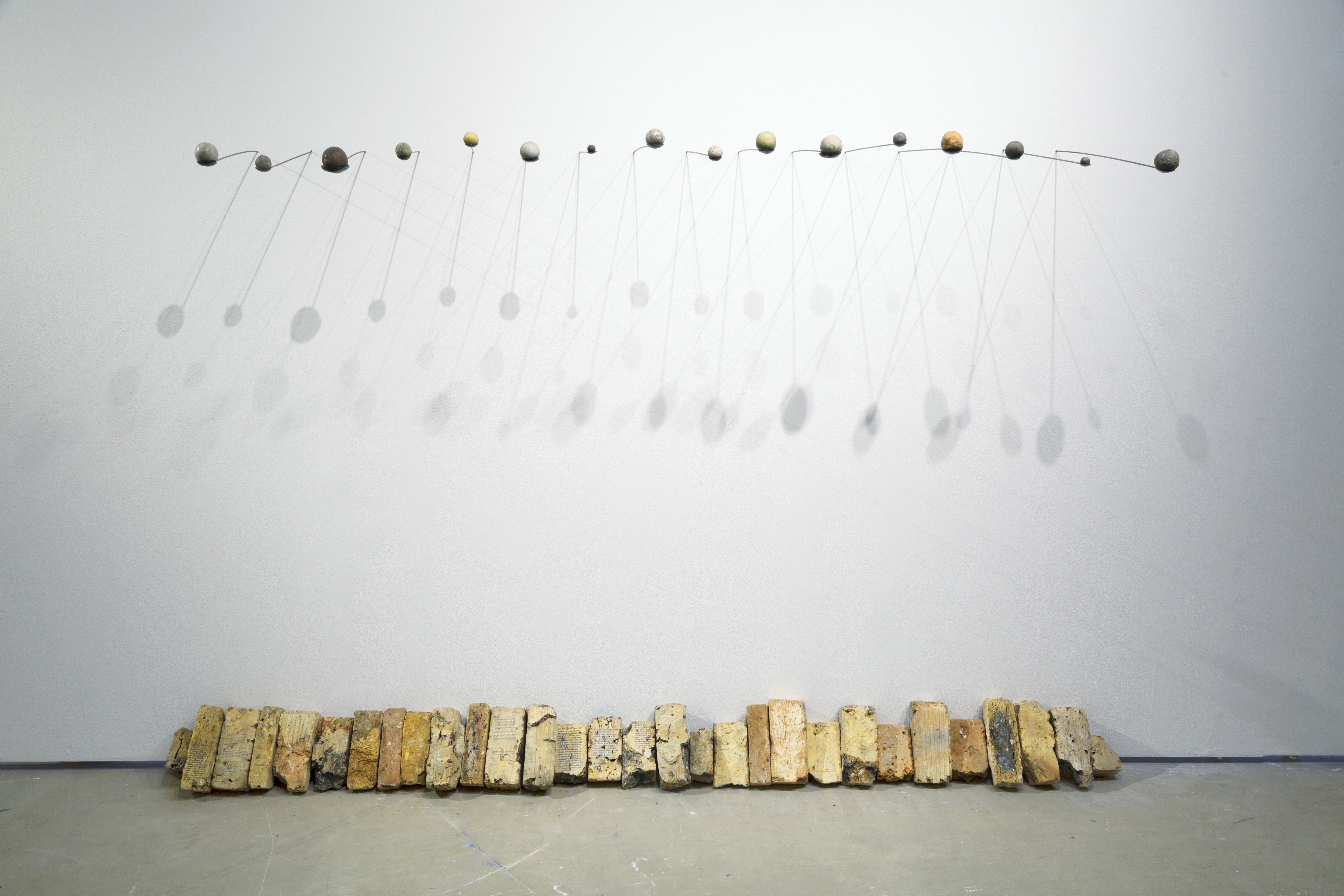



clay collected from construction sites in chicago, metal, engraved chicago common brick
The Issue You Mentioned Earlier
2019
Installation: video, fuse box, acrylic, metal, projection, mushrooms
Two- Person Exhibition collaboration with Alberto Trejo Oretga
2019
Installation: video, fuse box, acrylic, metal, projection, mushrooms
Two- Person Exhibition collaboration with Alberto Trejo Oretga
Chicago, IL
image credit: Brittany Laurent and Alberto Ortega
image credit: Brittany Laurent and Alberto Ortega





Installation: video, fuse box, acrylic, metal, projection, mushrooms
On March 19th, 2015, Florida’s emergency management chief Bryan Koon testified before the State Senate Budget Subcommittee on the news that the Federal Emergency Management Agency would pull federal funding from states that refuse to directly address climate change.
In alignment with his position of climate change denial, Koon went through a series verbal gymnastics to avoid using the scientific term for our current catastrophic path in his statements.A scaled steel cofferdam displays phrases exchanged in official emails by climate change deniers in the US Senate. Such phrases are projected over a melted piece of ice, residue of the Polar Vortex that hit Chicago one week before the opening of the show. Thuribles for a poisonous mushroom colloquially known as Destroying Angel embody the abstract threat of climate change. The gallery’s circuit box frames a nilometer that measures the scales of an Ideal Flood and a two channel video installation loops the works “Catastrophic Ice Formation” and “Order is human.”
Noise of Dust
2019
Group Exhibition with Carbon Copy Collective
Nathan’s Basement
Chicago, IL
Image Credit: Woojin Shin
2019
weather balloon, wood armature, white noise projection
Group Exhibition with Carbon Copy Collective
Nathan’s Basement
Chicago, IL
Image Credit: Woojin Shin
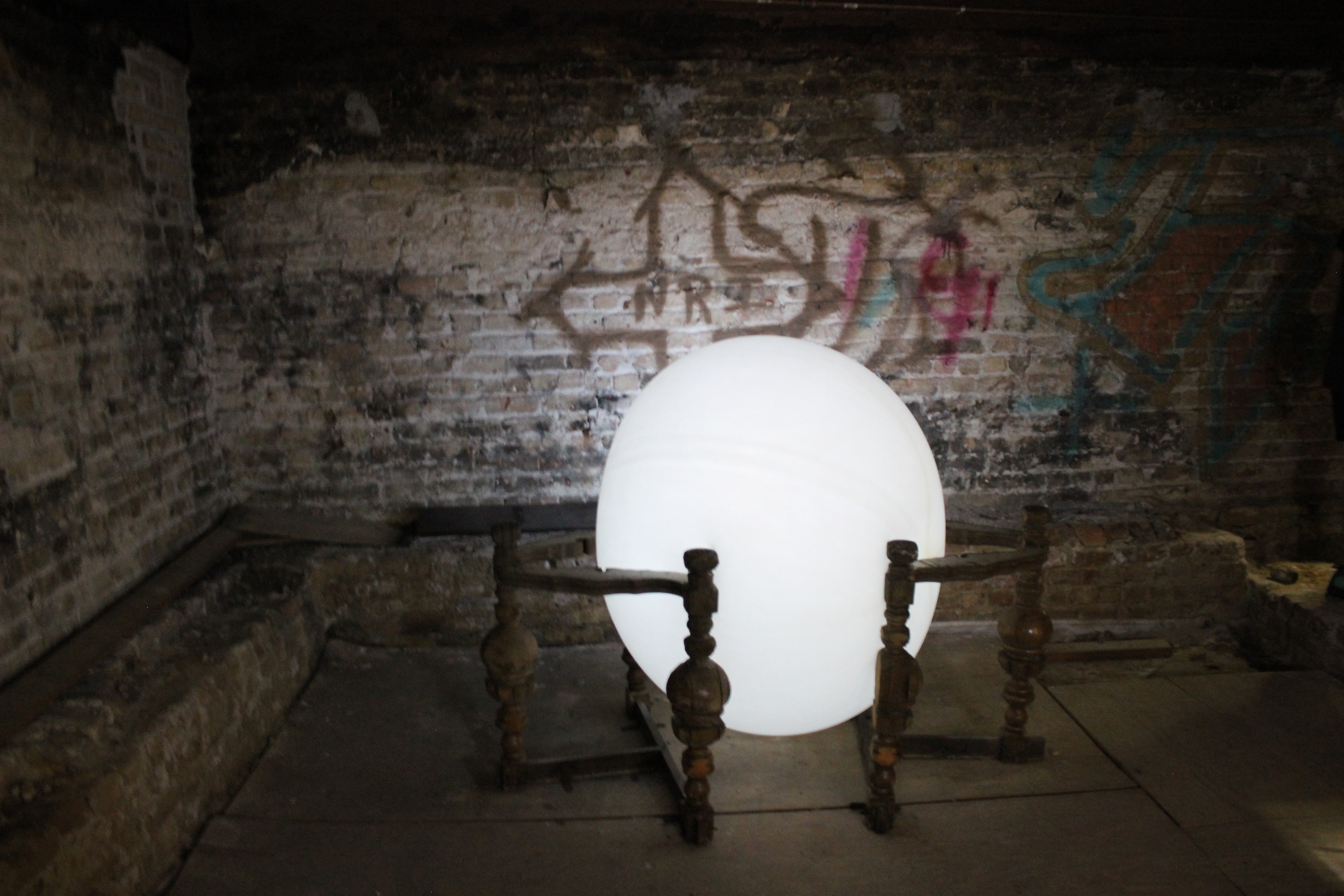




Die Prosperous
2020
locally harvested clay interventions, brick dust, plastic bag, metal hooks, rocks
Group Exhibition with Carbon Copy Collective
UGLY
Chicago, IL
2020
locally harvested clay interventions, brick dust, plastic bag, metal hooks, rocks
Group Exhibition with Carbon Copy Collective
UGLY
Chicago, IL
image credit: Astro Escuadero
The show's title is a mondegreen of "Diprosopus," the rare medical condition of two-headedness.
A Positive Negative
2018
locally harvested clay, blown glass, barn door
OxBow Fellowship Exhibition
Saugutuck Arts Center Saugutuck, MI
2018
locally harvested clay, blown glass, barn door
OxBow Fellowship Exhibition
Saugutuck Arts Center Saugutuck, MI


